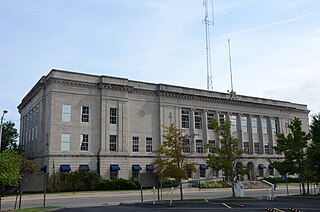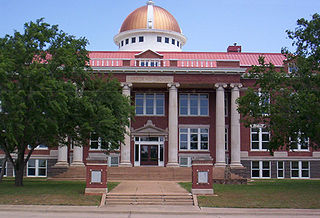Related Research Articles

Wagoner County is a county located in the U.S. state of Oklahoma. As of the 2020 census, the population was 80,981. Its county seat is Wagoner.

Muskogee County is a county located in the U.S. state of Oklahoma. As of the 2020 census, the population was 66,339. The county seat is Muskogee. The county and city were named for the Muscogee (Creek) Nation. The official spelling of the name was changed to Muskogee by the post office in 1900.

Cherokee County is a county located in the U.S. state of Oklahoma. As of the 2020 census, the population was 47,078. Its county seat is Tahlequah, which is also the capital of the Cherokee Nation.

Tahlequah is a city in Cherokee County, Oklahoma located at the foothills of the Ozark Mountains. It is part of the Green Country region of Oklahoma and was established as a capital of the 19th-century Cherokee Nation in 1839, as part of the new settlement in Indian Territory after the Cherokee Native Americans were forced west from the American Southeast on the Trail of Tears.

Lawton is a city in and the county seat of Comanche County, in the U.S. state of Oklahoma. Located in southwestern Oklahoma, approximately 87 mi (140 km) southwest of Oklahoma City, it is the principal city of the Lawton, Oklahoma, metropolitan statistical area. According to the 2020 census, Lawton's population was 90,381, making it the sixth-largest city in the state, and the largest in Western Oklahoma.

Muskogee is the 13th-largest city in Oklahoma and is the county seat of Muskogee County. Home to Bacone College, it lies approximately 48 miles (77 km) southeast of Tulsa. The population of the city was 36,878 as of the 2020 census, a 6.0% decrease from 39,223 in 2010.
Taft is a town in Muskogee County, Oklahoma, United States. The population was 250 at the 2010 census, a decline of 28.4 percent from the figure of 349 recorded in 2000. The town began as an all-black town on land allotted to Creek Freedmen. It is named for President William Howard Taft.
Okay is a town along the east bank of the Verdigris River in Wagoner County, Oklahoma, United States. The population was 620 at the 2010 census, a 3.9 percent increase over the figure of 597 recorded in 2000.

Wagoner is a city in Wagoner County, Oklahoma, United States. The population was 8,323 at the 2010 census, compared to the figure of 7,669 recorded in 2000. It is the county seat of Wagoner County. Wagoner became the first city incorporated in Indian Territory on January 4, 1896.
Fort Gibson is a town in Cherokee and Muskogee counties in the U.S. state of Oklahoma. The population was 4,154 at the 2010 census, an increase of 2.5 percent over the figure of 4,054 recorded in 2000. It is the location of Fort Gibson Historical Site and Fort Gibson National Cemetery and is located near the end of the Cherokees' Trail of Tears at Tahlequah.

Bixby is a city in Tulsa and Wagoner counties in the U.S. state of Oklahoma, and is a suburb of Tulsa. The population was 28,609 at the 2020 census and 20,884 in the 2010 census, an increase of 13.70 percent In 2010, Bixby became the 19th largest city in Oklahoma. It is nicknamed "The Garden Spot of Oklahoma" for its rich agrarian heritage. Though one of the fastest-growing communities in Oklahoma, it remains a sod-growing center and a popular location for purchasing fresh vegetables. The per capita income of $36,257 is the highest in the Tulsa Metropolitan area and is more than 50 percent higher than the state average.
Teddy Lehman is an American former college and professional football player who was a linebacker in the National Football League (NFL) for seven seasons. He played college football for the University of Oklahoma, and was twice recognized as a consensus All-American. The Detroit Lions chose him in the second round of the 2004 NFL Draft, and he also played for the Buffalo Bills and Jacksonville Jaguars of the NFL, and the Las Vegas Locomotives of the United Football League (UFL).

Bass Reeves was an enslaved Manservant, runaway slave, gunfighter, farmer, scout, tracker, Railroad Agent and Deputy U.S. Marshal. He spoke and understood the Five Civilized Tribal languages including Cherokee, Choctaw, Chickasaw, Seminole and Creek. Bass was one of the first African-American Deputy U.S. Marshals west of the Mississippi River mostly working in the deadly Indian Territory. The region was saturated with horse thieves, cattle rustlers, gunslingers, bandits, bootleggers, swindlers, and murderers. Bass made more than 3,000 to 4,000 arrests in his lifetime, only killing twenty men in the line of duty.

Fort Gibson is a historic military site next to the modern city of Fort Gibson, in Muskogee County Oklahoma. It guarded the American frontier in Indian Territory from 1824 to 1888. When it was constructed, the fort was farther west than any other military post in the United States. It formed part of the north–south chain of forts that was intended to maintain peace on the frontier of the American West and to protect the southwestern border of the Louisiana Purchase. The fort succeeded in its peacekeeping mission for more than 50 years, as no massacres or battles occurred there.

The Tulsa metropolitan area, officially defined as the Tulsa metropolitan statistical area is a metropolis in northeastern Oklahoma centered around the city of Tulsa and encompassing Tulsa, Rogers, Wagoner, Osage, Creek, Okmulgee and Pawnee counties. It had a population of 1,034,123 according to the 2022 U.S. census estimates.
Since the 1994 film Natural Born Killers was released, several attacks suspected to be copycat crimes have been committed by fans of the film, mostly by high school students within the age range of 15 to 18. Though apparent links have been claimed between the film and most of the incidents described below, certain causality has not been proven.
This is a list of the first five seasons of what is now the Tulsa Golden Hurricane football program.
Kate Frank was a Missouri-born, Oklahoma teacher who taught for nearly 50 years. She was instrumental in the founding of the Oklahoma Education Association, served as its first president, and later, donated the initial monies for the trust that became a legal defense fund for educators. She served as vice president of the National Education Association in the 1940s and was the first national Retired Teacher of the Year recipient. Honored by many awards, she was inducted into the Oklahoma Women's Hall of Fame in 1983.

Lillian Gallup Haskell was the inaugural First Lady of Oklahoma. She was inducted into the Oklahoma Hall of Fame in 1939.
The Ozark and Cherokee Central Railway (O&CC) was formed under the name of the North Arkansas & Western Railway in 1899. At its maximum, it owned a standard gauge, single track line running between Fayetteville, Arkansas and Okmulgee, Oklahoma. Its assets were merged into the St. Louis and San Francisco Railway (Frisco) in 1907.
References
- ↑ "2020 CENSUS - SCHOOL DISTRICT REFERENCE MAP: Muskogee County, OK" (PDF). U.S. Census Bureau. Archived (PDF) from the original on 2022-10-09. Retrieved 2024-03-19. - Text list
- ↑ Jackson Jaguars sign Teddy Lehman
- ↑ "Classmate, 13, held in shootings of Oklahoma students". CNN. December 6, 1999. Archived from the original on March 4, 2021. Retrieved May 3, 2013.